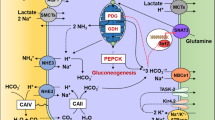Summary
The influence of digitoxin, epinephrine, propranolol, changes of Ca++, and of K+-concentrations in the coronary flow and in the cardiac nucleotide metabolism were studied in 100 normal and hypertrophied guinea pig hearts. Digitoxin decreased the coronary flows and the myocardial adenosine contents. Epinephrine increased the coronary flows and the myocardial adenosine contents. Propranolol perfusions resulted in small coronary flow decreases without any significant change of the, cardiac nucleotide metabolism. Hypercalcemia decreased the coronary flow levels and the myocardial adenosine contents. Hypocalcemia excessively increased the coronary flows and the myocardial adenosine values. Hyperkalemia reduced the coronary flows but the responses for the flow increase to additional adenosine were greater than in controls. Hypokalemia exerted an increase of coronary flows and of adenosine in the myocardium, the flow responses to adenosine injections, however, were reduced.
Zusammenfassung
An 100 normalen und hypertrophierten Meerscheinchenherzen wurde die Wirkung von Digitoxin, Epinephrin, Propranolol, von Ca++- und K+-Konzentrationsänderungen in den Infusionslösungen auf den Koronargefäßdurchfluß und den Herz-Nukleotid-Stoffwechsel untersucht. Digitoxin setzte den Koronardurchfluß und den myokardialen Adenosingehalt herab, während Epinephrin, beides erhöhte. Propranolol bewirkte ein geringes Absinken des Koronarflusses ohne Veränderungen des Adeninnukleotid-Stoffwechsels. Hyperkalzämie bewirkte eine Einschränkung des Koronardurchflusses und verringerte den Adenosingehalt im Myokard. Bei Hypokalzämie ließ sich ein erheblicher Anstieg des Koronargefäßdurchflusses und des myokardialen Adenosingehaltes nachweisen. Mit einer Hyperkalzämie wurde ein geringeres Ausmaß der Verminderung des Koronargefäßflusses erreicht als mit einer Hyperkalzämie. Im Gegensatz zu der verminderten Koronargefäßdurchblutung ließ sich nach Adenosininjektionen ein größerer Anstieg des Koronarflusses erkennen als vor der hyperkalämischen Infusion. Bei Hypokalämie konnte ein gerade entgegengesetztes Verhalten des Koronardurchflusses mit leicht vermehrten Werten und einer verminderten Reaktion auf Adenosininjektionen gefunden werden.
Similar content being viewed by others
References
Dobson, G., Jr., R. Rubio, M. M. Berne, Circulat. Res.29, 375–384 (1971).
Degenring, F. H., Basic Res. Cardiol.71, 287–290 (1976).
Author information
Authors and Affiliations
Additional information
With 3 tables
Rights and permissions
About this article
Cite this article
Degenring, F.H. Cardiac nucleotides and coronary flow during changes of cardiac inotropy. Basic Res Cardiol 71, 291–296 (1976). https://doi.org/10.1007/BF01906454
Received:
Issue Date:
DOI: https://doi.org/10.1007/BF01906454




